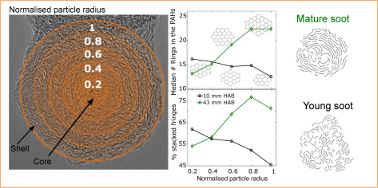Technical Report 209, c4e-Preprint Series, Cambridge
Internal structure of soot particles in a diffusion flame
Reference: Technical Report 209, c4e-Preprint Series, Cambridge, 2018
- Radial distribution of fringes within soot primary particles quantified using HRTEM fringe analysis.
- The most abundant PAHs in young and mature soot have approximately 7 aromatic rings.
- Young soot particles have a more ordered core compared to the surface with median PAH sizes of 12-16 rings.
- The particles develop a core-shell structure through graphitisation at T>1500K.
 The evolution of the internal structure of soot particles was studied in an ethylene coflow diffusion flame. Soot samples were thermophoretically extracted from the centreline of the flame and imaged with a high resolution electron microscope. The morphology and nano-structure of the particles was quantified using image analysis algorithms. The lattice-fringe algorithm was extended to correlate the fringe characteristics with their spatial location within the primary particles, allowing the study of radial changes in the distribution of the fringes length, spacing and tortuosity within the particles. The approximate molecule size was derived from the fringe length, assuming planar peri-condensed PAHs with D2h symmetry. The smallest soot particles sampled with diameters of approximately 10 nm have poor nano-structural order and some exhibit multiple nuclei. The molecules within these particles are of similar sizes, being slightly larger and more stacked at the core (~16 aromatic rings) than at the surface (~12 aromatic rings). This suggests that these particles could be formed from the coagulation of stable nuclei of larger PAHs and the condensation of smaller PAHs on their surface. The young soot particles were observed to grow in size in the lower temperature region (<1500 K) mainly at the particle surface, whereas at the core the molecules were observed to become less stacked and slightly smaller, indicating some degree of nano-structural mobility at flame temperatures. As the particles travel through the higher temperature region of the flame (>1500 K), the primary particles cease to grow and a graphitisation process takes places with the development of a shell of longer, flatter and more compact molecules (~20 aromatic rings). This process starts from the surface and spreads towards the centre of the particle, with a progressively thicker shell and an immobilised amorphous core. At the tip of the flame the particles are oxidised, mainly through surface oxidation. There is a decrease in the molecule sizes and stacking only at the shell of the particles, suggesting low diffusion of oxygen to the core of the particles.
The evolution of the internal structure of soot particles was studied in an ethylene coflow diffusion flame. Soot samples were thermophoretically extracted from the centreline of the flame and imaged with a high resolution electron microscope. The morphology and nano-structure of the particles was quantified using image analysis algorithms. The lattice-fringe algorithm was extended to correlate the fringe characteristics with their spatial location within the primary particles, allowing the study of radial changes in the distribution of the fringes length, spacing and tortuosity within the particles. The approximate molecule size was derived from the fringe length, assuming planar peri-condensed PAHs with D2h symmetry. The smallest soot particles sampled with diameters of approximately 10 nm have poor nano-structural order and some exhibit multiple nuclei. The molecules within these particles are of similar sizes, being slightly larger and more stacked at the core (~16 aromatic rings) than at the surface (~12 aromatic rings). This suggests that these particles could be formed from the coagulation of stable nuclei of larger PAHs and the condensation of smaller PAHs on their surface. The young soot particles were observed to grow in size in the lower temperature region (<1500 K) mainly at the particle surface, whereas at the core the molecules were observed to become less stacked and slightly smaller, indicating some degree of nano-structural mobility at flame temperatures. As the particles travel through the higher temperature region of the flame (>1500 K), the primary particles cease to grow and a graphitisation process takes places with the development of a shell of longer, flatter and more compact molecules (~20 aromatic rings). This process starts from the surface and spreads towards the centre of the particle, with a progressively thicker shell and an immobilised amorphous core. At the tip of the flame the particles are oxidised, mainly through surface oxidation. There is a decrease in the molecule sizes and stacking only at the shell of the particles, suggesting low diffusion of oxygen to the core of the particles.
Material from this preprint has been published in Carbon.
PDF (14.5 MB)



